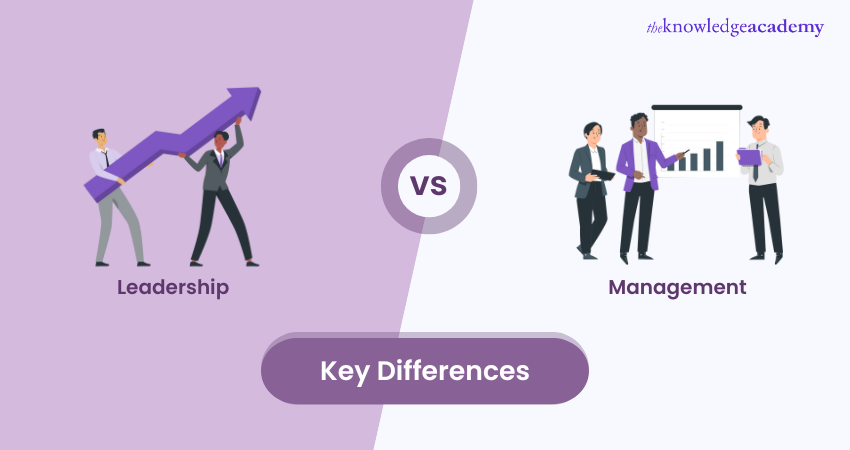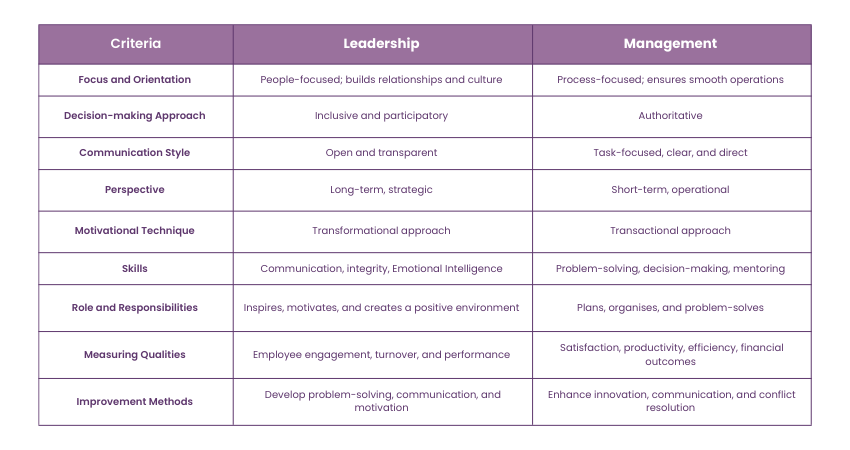We may not have the course you’re looking for. If you enquire or give us a call on 01344 203999 and speak to our training experts, we may still be able to help with your training requirements.
Training Outcomes Within Your Budget!
We ensure quality, budget-alignment, and timely delivery by our expert instructors.

Imagine being part of a team where one person inspires a shared vision and motivates everyone to achieve great things, while another ensures every detail is carefully planned and executed. This dynamic highlights the Difference Between Leadership and Management, showing how these roles bring unique strengths to a team.
Understanding the Difference Between Leadership and Management is essential for anyone aiming to grow professionally. Some individuals excel at inspiring and guiding others as Leaders, while others shine in organising and managing tasks effectively. Let’s explore how these two roles complement each other to drive organisational success.
Table of Contents
1) What is Leadership?
2) What is Management?
3) The Differences Between Leadership and Management
4) What are the Similarities Between Leadership and Management?
5) How to Become a Better Leader or Manager?
6) How to Measure Effective Leadership and Management?
7) Conclusion
What is Leadership?
Leadership is a fundamental concept that plays a crucial role in various aspects of life, including business, politics, and social settings. It encompasses the ability to guide, inspire, and influence individuals or groups towards achieving a common goal.
Leadership is a process of social influence which aims to maximise the efforts of others towards achieving a common goal. A Leader takes initiative and invests extensively to accomplish a goal. This is the reason why people follow them.
A Leader is someone who possesses certain traits and skill sets that enable them to effectively lead and motivate others. Additionally, Leaders often serve as role models, embodying the values and principles they espouse.
What is Management?
Management involves executing pre-planned tasks and responsibilities using available resources. Its primary aim is to achieve organisational goals efficiently. This requires coordination across various departments within the organisation. Management can evolve into leadership by inspiring and motivating others, embracing new perspectives, and solving problems.
The Differences Between Leadership and Management
Leadership and Management, though often used interchangeably, are fundamentally different in their approaches, focus, and outcomes. While both roles are essential for the success of an organisation, it is crucial to understand the contrasting aspects of Leadership and Management.

1) Difference in Focus and Orientation
Leadership typically focuses on the people aspect of an organisation. Leaders encourage and inspire people or groups to acquire a shared vision and dreams. They prioritise growing relationships, fostering a high-quality work lifestyle, and aligning the efforts of the team closer to a common cause. Leadership is about guiding and influencing others, empowering them to unharness their complete potential.
On the other hand, Management specialises in strategies, systems, and duties. Managers are typically accountable for planning, organising, and coordinating the resources and activities required to achieve unique goals. They make sure that the operational components of the corporation run easily, efficaciously allocating assets, tracking progress, and imposing strategies. Management emphasises control, performance, and accomplishing predefined goals.
2) Difference in Decision-making Approaches
Leadership and Management vary of their methods to decision-making. Leaders frequently undertake an extra inclusive and participatory style, related to others in the decision-making manner. They look for input, take into account numerous views, and inspire collaboration. Leaders recognise the significance of collective intelligence and value the contributions in their team members.
In comparison, Management normally follows a greater authoritative decision-making approach. Managers examine facts, evaluate options, and make selections based totally on their expertise and authority. They are accountable for the results and need to ensure that decisions align with organisational desires and goals.
3) Differences in Communication Styles
Communication styles also vary between Leadership and Management. Leaders employ open and transparent communication to inspire and motivate their teams. They share a compelling vision, provide clear direction, and proactively listen to the concerns and ideas of their followers. Effective communication skills enable Leaders to connect with others on an emotional level, building trust and fostering a positive work environment.
Managers, on the other hand, focus on operational communication. They prioritise sharing information related to tasks, deadlines, and performance expectations. Managers utilise communication as a tool for coordination so everyone stays aligned and works towards shared goals.
4) Difference in Long-term vs Short-term Perspective
Leadership tends to have a long-term perspective, emphasising strategic thinking and envisioning the future. Leaders consider the broader picture, set long-term goals, and develop strategies to achieve sustainable success. They focus on innovation, adaptability, and long-term growth, taking calculated risks and embracing change.
In contrast, Management often has a short-term perspective, focusing on immediate objectives and operational efficiency. Managers are responsible for implementing plans, monitoring progress, and meeting targets within specific timeframes. They prioritise maintaining stability, optimising resources, and delivering consistent results.
Start your journey towards excellence – sign up for our ILM Level 5 Diploma in Leadership and Management now!
5) Difference in Motivational Techniques
Leaders and Managers rent exceptional motivational techniques to encourage and have interaction with their teams. Leaders use transformational leadership approaches, which involve inspiring individuals to surpass their personal expectations and obtain outstanding outcomes. Leaders concentrate on intrinsic motivation, empowering individuals to take ownership in their work and make a contribution meaningfully.
Managers frequently undertake transactional leadership strategies, which contain imparting rewards, reputation, and incentives to encourage employees. They concentrate on extrinsic motivation, the use of rewards and results to drive performance and make certain compliance with installed requirements and approaches.
6) Difference in Role and Responsibilities
Let us understand the difference between the roles and responsibilities of Leadership and Management:
a) Role and Responsibilities of Leaders:

Leaders assume various roles and responsibilities within their respective domains. They act as visionaries, setting a clear direction and inspiring others to follow. A Leader provides guidance, support, and mentorship to individuals or teams, helping them reach their full potential.
b) Role and Responsibilities of Managers:

Managers are responsible for overseeing and guiding the day-to-day operations of a team or department, ensuring that tasks are executed efficiently and effectively. They are responsible for setting goals, defining objectives and determining the best course of action.
What are the Similarities Between Leadership and Management?
While Leadership and Management are renowned concepts, they share numerous key similarities which can be critical for the fulfillment of any enterprise. Understanding these commonalities can help individuals excel in both areas and make a contribution more correctly to their groups:
a) Vision and Strategy: Both Leaders and executives want to have a clean imaginative and prescient and method to manual their groups and attain organisational desires.
b) Decision-making: Effective decision-making is critical for both roles, as they want to make informed selections that gain the employer.
c) Influence and Motivation: Both Leaders and bosses must be able to influence and encourage their teams to perform at their best
d) Accountability: Both roles require a high level of responsibility for their moves and the performance of their teams.
e) Adaptability: Leaders and executives ought to be adaptable to changing circumstances and be able to pivot techniques when required.
Gain the essential skills to lead effectively – sign up for our ILM Level 5 Award in Leadership and Management.
How to Become a Better Leader or Manager?
When it comes to Leadership and Management, there is some overlap in skills but there are also key differences. To improve your chances of securing or advancing in a Leadership or Management role, focus on developing these essential skills:
a) Attention to Detail: Crucial for both roles. Managers use it to identify flaws, while Leaders use it to develop innovative solutions. Analysing situations in detail is vital for both.
b) Communication Skills: Essential for sharing information and active listening. Strong communicators excel in teaching and learning from others.
c) Goal Setting: Leaders set goals; Managers ensure they are achieved. Effective goal setting and achievement help teams meet their objectives.
d) Interpersonal Skills: Leaders inspire and motivate through positive interactions. Managers focus on conflict resolution and team building, ensuring effective collaboration.
e) Problem-solving Skills: Beneficial for all professionals. Leaders seek solutions for the company, while Managers find solutions for daily departmental tasks.
How to Measure Effective Leadership and Management?
Understanding how to measure effective Leadership and Management is important for any organisation aiming for success. By evaluating various aspects of performance, you can identify strengths and areas for improvement. Here are some key metrics to consider:
a) Employee Satisfaction and Engagement: Assess the morale and engagement levels of employees through surveys and feedback. High satisfaction often indicates effective Leadership and Management.
b) Achievement of Organisational Goals: Evaluate the extent to which organisational objectives and targets are met. Consistent achievement reflects strong management and leadership.
c) Team Performance and Productivity: Monitor the performance and productivity of teams. Effective Leaders and Managers foster high-performing teams.
d) Innovation and Problem-solving: Measure the frequency and impact of innovative solutions and problem-solving initiatives. Leaders who inspire creativity contribute to organisational success.
e) Communication and Collaboration: Assess the quality of communication and collaboration within the organisation. Effective Leadership and Management are characterised by clear, open, and productive interactions.
f) Employee Development and Retention: Track the development and retention rates of employees. Leaders and Managers who invest in their teams' growth tend to retain top talent.
g) Financial Performance: Analyse financial metrics such as revenue growth, profitability, and cost management. Strong leadership and management often correlate with robust financial health.
Conclusion
Understanding the Difference Between Leadership and Management is crucial for navigating the complexities of any organisation. While Management ensures efficiency and order, Leadership drives innovation and inspiration. By mastering both, you can achieve a balanced approach that fosters growth and success.
Take the next step in your professional development by joining our ILM Level 5 Certificate in Leadership and Management.
Frequently Asked Questions

To improve leadership skills, separate from management, focus on developing strategic vision, Emotional Intelligence, and the ability to inspire and motivate teams. Engage in mentorship, seek feedback, and practice active listening.

Leadership drives long-term goals, while management ensures day-to-day operations run smoothly. Both are crucial in a business setting; leadership fosters innovation and direction, whereas management brings organisation and efficiency. A balance between both is essential for sustained success.

The Knowledge Academy takes global learning to new heights, offering over 30,000 online courses across 490+ locations in 220 countries. This expansive reach ensures accessibility and convenience for learners worldwide.
Alongside our diverse Online Course Catalogue, encompassing 19 major categories, we go the extra mile by providing a plethora of free educational Online Resources like News updates, Blogs, videos, webinars, and interview questions. Tailoring learning experiences further, professionals can maximise value with customisable Course Bundles of TKA.

The Knowledge Academy’s Knowledge Pass, a prepaid voucher, adds another layer of flexibility, allowing course bookings over a 12-month period. Join us on a journey where education knows no bounds.

The Knowledge Academy offers various ILM Level 5 Courses, including the ILM Level 5 Award in Leadership and Management, ILM Level 5 Certificate in Leadership and Management, and ILM Level 5 Diploma in Leadership and Management. These courses cater to different skill levels, providing comprehensive insights into Management Reporting.
Our ILM, CMI Leadership & Management Blogs cover a range of topics related to Leadership and Management strategies, offering valuable resources, best practices, and industry insights. Whether you are a beginner or looking to advance your Leadership and Management skills, The Knowledge Academy's diverse courses and informative blogs have got you covered.
Upcoming ILM, CMI Leadership & Management Resources Batches & Dates
Date
 ILM Level 3 Award in Leadership and Management
ILM Level 3 Award in Leadership and Management
Fri 21st Feb 2025
Fri 9th May 2025
Fri 15th Aug 2025
Fri 5th Dec 2025







 Top Rated Course
Top Rated Course



 If you wish to make any changes to your course, please
If you wish to make any changes to your course, please


